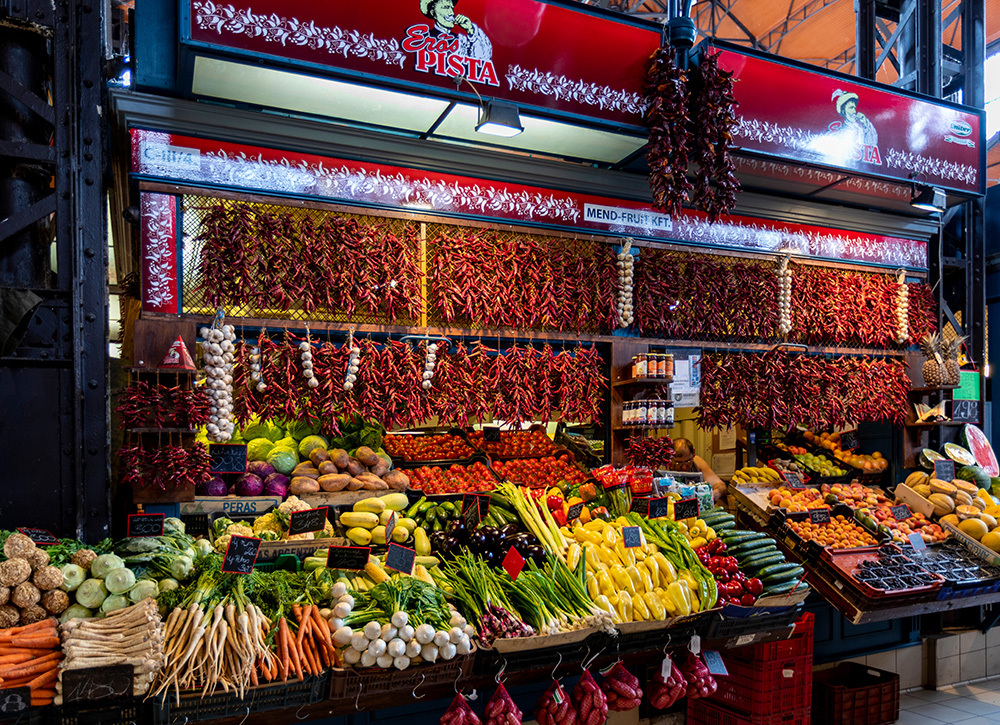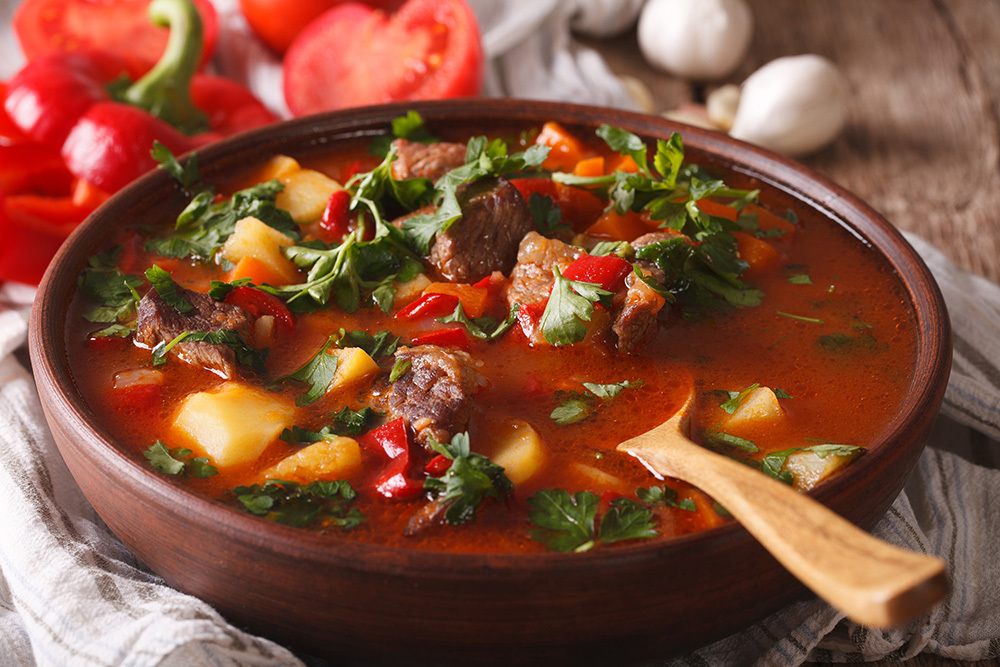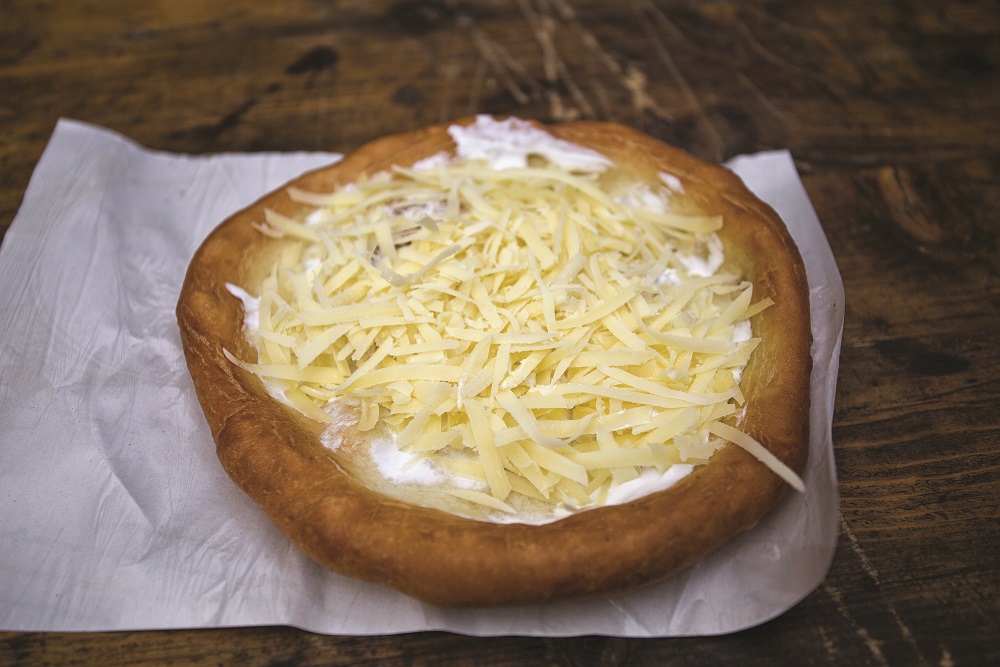Hungarian cuisine is well-known for paprika, black pepper, onion, and garlic. Although traditional Hungarian dishes are primarily based on meats and dairy products, the country offers a wide selection of seasonal fruits and vegetables throughout the year thanks to its excellent geographical location. To discover the hidden culinary treasures of the country, let us invite you to a day of eating traditional Hungarian meals.

A typical Hungarian breakfast starts with fresh white bread (popular alternatives are bread rolls called “zsemle”, or the crescent moon-shaped “kifli”) top it with cold cut meats (“kolbász” or “szalámi”) and adds fresh vegetables: tomatoes, onion, or pepper. Hungarians tend to like their breakfasts on the savoury side, but if you have a sweet tooth, you can also choose milk bread (“kalács”) with fresh fruits.
For lunch, which is the main meal of the day, get ready for a three-course menu: soup is usually followed by a main dish and a dessert. You may have heard of the famous Hungarian gulyás soup that was accredited as a Hungaricum in 2017. Traditional Goulash is made from root vegetables and beef, but you can opt for a vegetarian version too. Another famous soup is fisherman's soup (“halászlé”): a velvety, paprika-infused broth with thick cuts of river fish in it. Since Hungary is rich in water resources as it has the river Tisza, river Danube and several lakes, it is easy to try special types of local fish.

As for the main dish, stews and meat cuts tend to dominate the traditional scene (such as Hungarian chicken stew, “rostélyos” or “vadas”) but vegetable stews called “főzelék” are also widely served. Pasta dishes, both sweet (such as plum dumplings - “szilvás gombóc”) and savoury (as cottage cheese - “túrós tészta”) are a popular choice too.
Dinner is usually served cold, including meat cuts, fresh cheese, and dairy products (try the Hungarian cottage cheese “túró”, or sour cream “tejföl” or the seasoned mixture of these two “körözött”) with vegetables.
Savoury must-tries include “lángos” which is a plate-sized sheet of deep-fried dough, usually smothered with sour cream and topped with grated cheese. Stuffed cabbage called “töltött káposzta” is a popular dish too: large leaves of fermented cabbage, stuffed with meat and rice, cooked and then topped with sour cream; or the well-known “lecsó”:, the paprika-based vegetable stew of onions, tomatoes and peppers with variations including sausage and egg.

Sweet must-tries: don’t miss out on the Dobos cake, a chocolate buttercream-layered sponge cake, topped with crystallized caramel and covered with nuts on the edges, neither the chimney cake (“kürtős kalács”) or the incredibly popular Túró Rudi, a dark chocolate bar filled with sweetened cottage cheese (“túró”), available in different flavours or with jam fillings as well.
Did you know?
To celebrate Hungarian culinary innovation, “The Cake of Hungary” (Magyarország Tortája) contest is organized each year on the occasion of the national holiday on 20 August, the day when Saint Stephen founded the Hungarian State. In 2023, the cake called "Spicces Füge Respectus" — an Aszú-flavored fig creation with honey by master confectioner Pál Lakatos from Szigetszentmiklós has been awarded as the winner. The Sugar-Free Cake of Hungary in 2023 is the "Kikelet" by confectioner Zsófia Lawal-Papp from Makó – a cake with a drop of black tea, blueberries, and lavender completed with vanilla white chocolate mousse.
From August 19, you can taste the cakes in the Várkert Bazaar in Magyar Ízek Utcája and in hundreds of pastry shops across the country.

Special food options in Hungary:
• Special dietary needs
Just like any other European country, Hungary has caught up with healthy food trends. You can buy gluten- and lactose-free products in most supermarkets. For instance, a wide range of milk substitute products are available in stores. In addition, whole grain products have become ever so popular nationwide.
• Kosher or Halal food in Hungary
Yes, numerous restaurants and supermarkets are selling kosher and halal food. Due to its size, Budapest has the largest number of places where religious dietary options are available. However, bigger university towns, such as Debrecen or Szeged, also provide access to food options.
• Vegan, vegetarian options
Although Hungarian cuisine is famous for its meat-based dishes, you would be surprised how easy it is to find places to eat well without meat or animal products. There are numerous Hungarian dishes prepared with potato, cauliflower, cheese, mushroom or zucchini. Salads are also well-known in Hungarian cuisine and are popular. There are several restaurants which specialise in the needs of vegetarians or vegans. If you want to cook at home, you can find more and more alternatives in shops to substitute meat with other options.
Sources: The Cake of Hungary - cukraszat.net